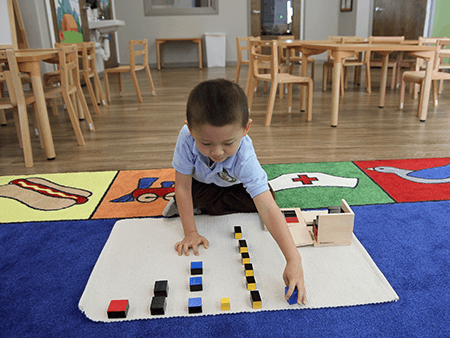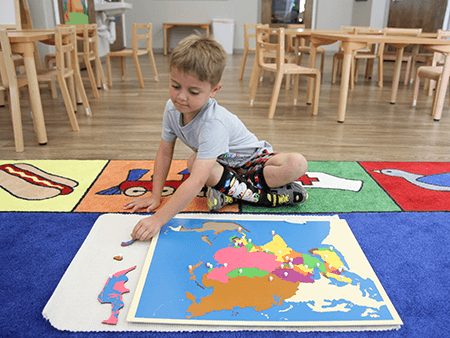Welcome to Harvest Green Montessori School!
Kindergarten/First Grade
When the child begins to think and to make use of
the written language to express his rudimentary
thinking, he is ready for elementary work; and this
fitness is a question not of age or other incidental
circumstance but of mental maturity.
- Maria Montessori


Some Highlights Of Our Kindergarten Program Are:
The Montessori curriculum allows us to continually challenge each child at his/her own pace.We highly value our close working relationships with our families. This partnership is fostered through ongoing, personal communication as well as multiple conferences each year.
The multi-age classroom stimulates enthusiasm for learning and inspires independent thinking.
All of our teachers have Montessori certified with extensive experience in the classroom.
We provide a large outdoor, as well as an indoor space, specifically designed to meet the young child's need for gross motor development.
Our program includes Montessori curriculum along with regularly scheduled enrichment activities which may include Spanish, Art and yoga. Each taught by teachers that are specifically trained in these disciplines.
Curriculum
Advanced Practical Life
When children enter the Montessori Kindergarten program, they are already familiar with basic practical life activities. Now, they are presented with the opportunity to apply their acquired skill set to real world activities. They also learn basic etiquette and sewing where they create projects using running stitch, cross stitch, and blanket stitch. These Advanced Practical Life activities help children develop a high level of concentration, patience, and improve their fine motor skills, while evoking a sense of respect for others and their environment.
Sensorial
Sensorial materials in the Montessori classroom are designed to help the child explore the world through their senses. Each of the sensorial materials isolates one defining quality such as color, weight, shape, texture, size, sound, and smell. The materials help children to distinguish, to categorize, and to relate new information to what they already know. The Sensorial Materials are largely self- correcting, so the child can accomplish the exercise alone. Children find a sense of order in these materials and acquire joy in learning that their environment has order.
Language
The development and sophistication of the child's oral and written language are critical to his/her success in school. An insatiable intellectual curiosity demands that knowledge not only is absorbed and retained but expressed and acknowledged by others in the learning environment. Careful attention is paid to the child's: Reading comprehension, Composition (descriptive, expository, persuasive), Language arts, Grammar, Sentence construction, Vocabulary, Study and use of different verbs and their tenses, Oral expression. These skills are taught in isolation and in direct association with writing and reading, which is where the child's true interests lie. Didactic materials, which are as precise, orderly, and appealing as those in mathematics and geometry, are the means for delivering instruction and enabling mastery.
Mathematics
All worldly functions are related to mathematics in one way or another. Thus, the ability to apply math skills in other areas of study such as art and sensory activities is most beneficial. The four basic mathematical operations of addition, subtraction, multiplication, and division are taught in detail, building on the skills learned in Pre-Kindergarten. Students work with the number categories of units, tens, hundreds, and thousands, comprehend the concept of zero and learn to tell time. They also learn to count into 2's, 5's and 10's. A majority of the math curriculum in dedicated to Geometry and related lessons include the Geometry Cabinet, Geometric Solids, Constructive Triangles and the Binomial and Trinomial Cubes.
Physical and Cultural Geography
In our Geography curriculum, our students look at the Earth, our home, study its weather, seasons, its various formations of land and water, and learn its place in the Solar System. A major portion of this curriculum consists of the study of world maps. Children explore the continents of the world, their culture and wildlife, and learn about the states that form United States of America. History and geography begin with the study of maps and the two hemispheres of Earth and becomes more and more detailed as children will learn about countries and Continents. The very young child will use the wooden puzzle maps as puzzles, but the older child can use the pieces as a guide as he makes his own maps, labeled with his own handwriting when he is ready.
Science and Nature
Children are introduced to many topics and learn to make predictions in their Science and Nature activities. The land and water work, introducing the concepts of Lake and Island, is closely connected to the geography curriculum. Children learn about volcanoes, the layers of the Earth and the solar system. Children will go on nature walks and then research the leaves and seed they have found. Activities include Sink or Float, Living or Non-Living, Magnetic or Non-Magnetic, Land and Water Forms, the Structure of the Earth and Botany.
Fine Art
Our students are exposed to several famous artists and their works. Children are introduced to the art techniques used by these established artists and are provided with an opportunity to experiment with various art media to create their own unique works of art.
Spanish and Other Languages
Children are taught to speak words, sentences, and rhythms of Spanish and other languages through games, songs, and activities. Lessons initially include counting, colors, and basic vocabulary.
